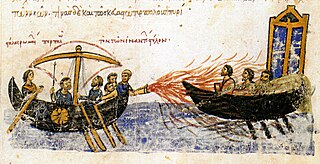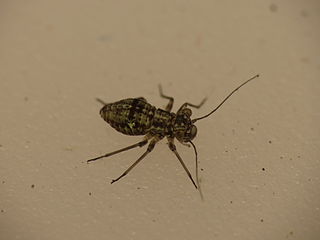
Latinus was a figure in both Greek and Roman mythology. He is often associated with the heroes of the Trojan War, namely Odysseus and Aeneas. Although his appearance in the Aeneid is irreconcilable with his appearance in Greek mythology, the two pictures are not so different that he cannot be seen as one character.

The Alexiad is a medieval historical and biographical text written around the year 1148, by the Byzantine princess Anna Komnene, daughter of Emperor Alexios I Komnenos. It was written in a form of artificial Attic Greek. Anna described the political and military history of the Byzantine Empire during the reign of her father, thus providing a significant account on the Byzantium of the High Middle Ages. Among other topics, the Alexiad documents the Byzantine Empire's interaction with the Crusades and highlights the conflicting perceptions of the East and West in the early 12th century. It does not mention the schism of 1054 – a topic which is very common in contemporary writing. Nevertheless it successfully documents firsthand the decline of Byzantine cultural influence in both eastern and western Europe, particularly in the West's increasing involvement in its geographic sphere.

Spalax is a genus of rodent in the family Spalacidae, subfamily Spalacinae. It is one of two extant genera in the subfamily Spalacinae, alongside Nannospalax.
In Greek mythology, Graecus was the son of Pandora of Thessaly and Zeus. His mother was the daughter of Deucalion and Pyrrha, and sister of Hellen who together with his three sons Dorus, Xuthus and Aeolus, comprised the set of ancient tribes that formed the Greek/Hellenic nation. His possible siblings were Melera and Pandorus.

The Madrid Skylitzes is a twelfth century illuminated manuscript version of the Synopsis of Histories, by John Skylitzes, which covers the reigns of the Byzantine emperors from the death of Nicephorus I in 811 to the deposition of Michael VI in 1057. The manuscript was produced in Norman Sicily and is now at the Biblioteca Nacional de España in Madrid, with the shelfmark MS Graecus Vitr. 26–2. Other names for it are Codex Græcus Matritensis Ioannis Skyllitzes and Skyllitzes Matritensis.
The Papyrus Graecus Holmiensis is a collection of craft recipes compiled in Egypt c. 300 AD. It is written in Greek. The Stockholm papyrus has 154 recipes for dyeing, coloring gemstones, cleaning (purifying) pearls, and imitation gold and silver. Certain of them may derive from the Pseudo-Democritus. Zosimos of Panopolis, an Egyptian alchemist of c. 300 AD, gives similar recipes. Some of these recipes are found in medieval Latin collections of technological recipes, notably the Mappae clavicula.
The Bukovina blind mole-rat or (erroneously) the Balkan blind mole-rat is a species of rodent in the family Spalacidae found in Romania, Moldova, and Ukraine.
Codex Vaticanus Graecus 64, is a Greek manuscript written on parchment, housed at the Vatican Library. It is written on 289 leaves. It was written in Thessaloniki about the year 1270.
Mesopsocus unipunctatus is a species of barklouse found across the Holarctic. It is a member of the Mesopsocidae family. It is a generalist that occurs on branches of deciduous and coniferous trees, as well as lower hedgerows and shaded meadows.

Mesopsocus immunis is a species of Psocoptera from the Mesopsocidae family that can be found throughout Western Europe, and Hungary.
Mesopsocus blancae is a species of Psocoptera from the Mesopsocidae family that is endemic to Spain.
Mesopsocus duboscqui is a species of Psocoptera from the Mesopsocidae family that can be found in Cyprus, France, Greece, Italy, Slovenia, and Spain.
Mesopsocus fuscifrons is a species of Psocoptera from the Mesopsocidae family that can be found in North Macedonia and Kaliningrad, Russia.
Mesopsocus helveticus is a species of Psocoptera from the Mesopsocidae family that can be found in Austria, Hungary, and Switzerland.

Pompeii is a 2014 epic romantic historical disaster film produced and directed by Paul W. S. Anderson. An international co-production between the United States, Germany and Canada, it is inspired by and based on the eruption of Mount Vesuvius in 79 A.D. that destroyed Pompeii, a city of the Roman Empire. The film stars Kit Harington, Emily Browning, Carrie-Anne Moss, Adewale Akinnuoye-Agbaje, Jessica Lucas, with Jared Harris, and Kiefer Sutherland.

The Sacra Parallela is a Byzantine florilegium of quotes from the Bible and patristic texts used in the instruction of ethics, morals and asceticism.
Pseudo-Simeon is the conventional name given to the anonymous author of a late 10th-century Byzantine Greek chronicle which survives in a single codex, Parisinus Graecus 1712, copied in the 12th or 13th century.

Mesopsocus is a genus of middle barklice in the family Mesopsocidae. There are more than 60 described species in Mesopsocus.
Mehely's blind mole-rat is an endangered species of rodent in the family Spalacidae. It is endemic to Romania.







